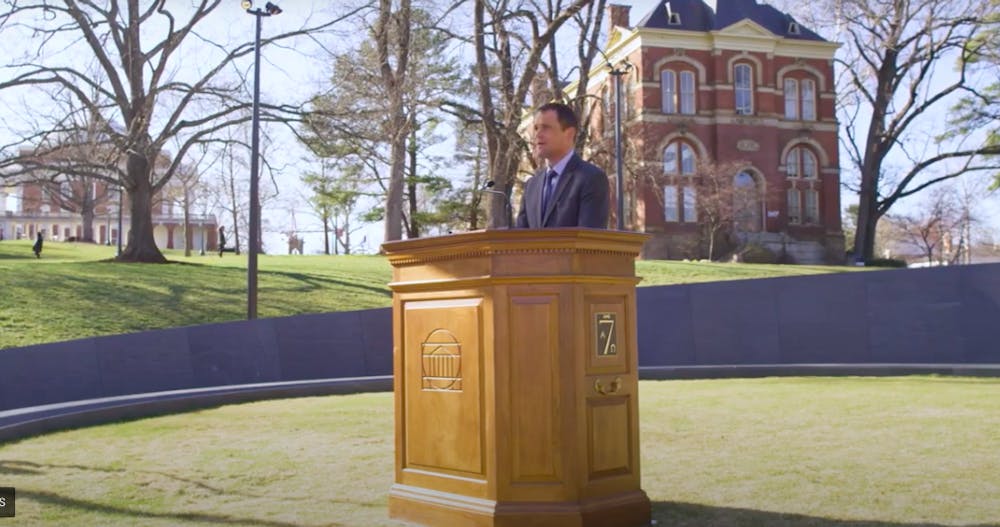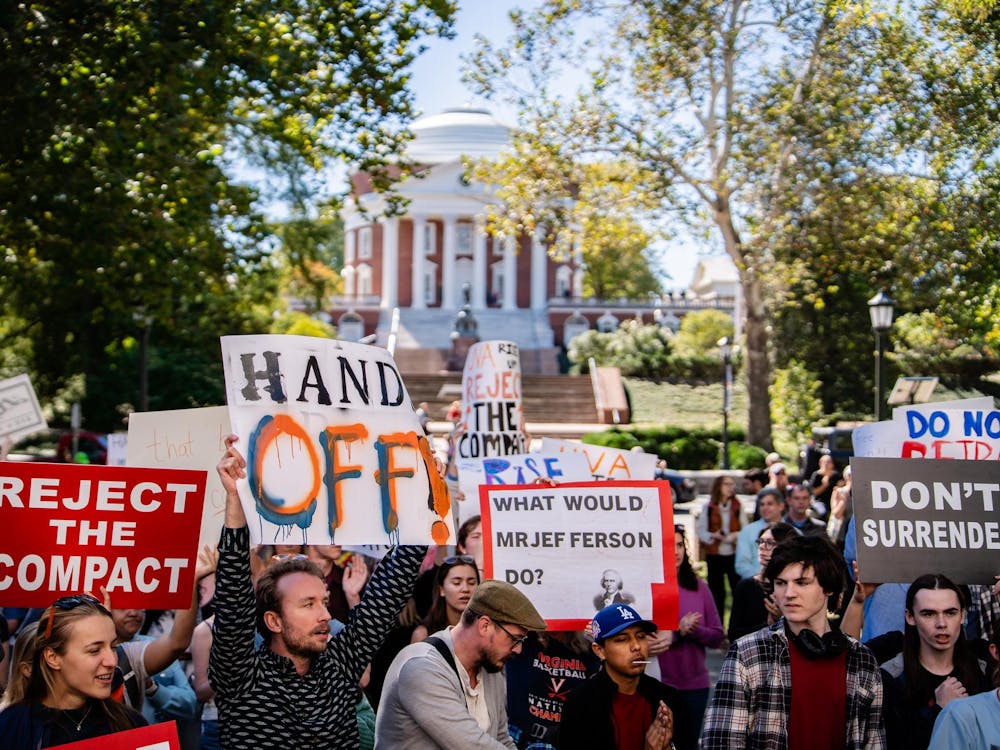The University officially dedicated the Memorial to Enslaved Laborers Saturday in a culmination of over a decade's worth of community and student activism surrounding the memorial’s construction. Numerous faculty, alumni, students, community members and descendants of enslaved laborers spoke at the dedication, which was streamed virtually.
The ceremony was part of a number of virtual events intended to celebrate the legacies of enslaved laborers of U.Va. and their descendants this weekend. At noon. Friday, the University community took part in a moment of silence, during which the water feature of the Memorial to Enslaved Laborers was turned on by descendants. Later that day, the Descendants of Enslaved Communities at U.Va. hosted its first public event — a virtual panel discussion on descendant communities in the Commonwealth. Take 6 — a Grammy-award winning a capella group — will also perform at a virtual concert celebrating the dedication Saturday at 7 p.m.
The dedication was originally supposed to take place more than a year ago but was postponed due to the pandemic. The Memorial — which was proposed more than a decade ago — was officially completed last spring.

The memorial was completed last spring.
Prior to the memorial’s construction, the only tribute to the free and enslaved communities at the University was a plaque installed in 2007 in the passage under the Rotunda’s south terrace that commemorated the “several hundred women and men, both free and enslaved” who built the University. Since its installation, the plaque has been criticized for its small size and failure to accurately represent the huge role free and enslaved laborers had in building and maintaining the University.
To begin the dedication ceremony, Class of 2019 alumna Jessica Harris gave a brief tour of the memorial and Reverend Alvin Edwards led a prayer.
University President Jim Ryan then began his remarks by quoting Isabella Gibbons, an enslaved laborer who taught herself how to read and write while enslaved at the University and established a school in Charlottesville for freed Black individuals after her emancipation in 1865. Gibbons House was named after both Gibbons and her husband William in 2015, and Isabella’s eyes are etched onto the stone on the outside of the Memorial to Enslaved Laborers.
“It is fittingly her words and her eyes through which we can feel the past, reach to the stone of the Memorial to Enslaved Laborers and impel us to greater understanding injustice in a year in which we have too often suffered heartache, isolation and loss,” Ryan said.
Within the context of the past year — which has included a global pandemic, challenges to democracy and global social justice movements protesting the deaths of Black citizens at the hands of law enforcement — the memorial serves as an especially important symbol of “healing and connection,” Ryan said.
“I'd like to express my profound gratitude for the work of so many at U.Va. and in the local community to dream, envision, design, research, collaborate, build and engrave the memorial.” Ryan said. “Their work will be remembered for as long as the granite from which the memorial is built endures.”
Ryan also addressed families with ties to the names, vocations and memory marks that appear on the memorial. More than 4,000 free and enslaved laborers worked and maintained the University between the 1817 and 1865 — the Memorial to Enslaved Laborers lists the known names of enslaved laborers in addition to 4,000 memory marks in recognition of those whose names are unknown.
“Your ancestors toiled often anonymously, facing violence and harassment and not under their freewill to build the University of Virginia,” Ryan said. “It is to them that we owe our deepest gratitude. May this memorial bring to their families a measure of solace in a step towards spiritual repair.”
Class of 2011 alumna Ishraga Eltahir and Class of 2009 alumnus Khalifa Sultan Lee then spoke to the student involvement and advocacy behind the memorial. Eltahir is the founding chair of the Memorial for Enslaved Laborers Student Committee while Lee is a winning team member of the 2011 Memorial Design Ideas Competition. Eltahir described being at the dedication ceremony 10 years later as “surreal.”
“A physical memorial is important and a long overdue addition to the University, but by no means is it an end for the simultaneous dismantling and building work that still needs to be done,” Eltahir said. “Even as we celebrate and congratulate, may we push forward in earnest.”

Lee is a winning team member of the 2011 Memorial Design Ideas Competition.
Teresa Sullivan, former Universtiy president and current interim provost at the University of Michigan, then remarked on the work of the President’s Commision on Slavery and the University, which she founded in 2013. The PCSU — a 26-person group made up of students, faculty, staff, administration, alumni and administration — delivered a final report to Sullivan in 2018 with recommendations on the memorial.
“People memorialize what is important to them, and with this memorial, the commission helps us ensure that the hidden lives of enslaved laborers are now publicly remembered for their importance to the University of Virginia,” Sullivan said.
Both Prof. Kirt von Daacke and Prof. Marcus Martin, co-chairs of the PCSU, spoke to the commission’s work and thanked Sullivan and the Board of Visitors for their support throughout the memorial’s development.
“We acknowledge the past and must learn from it, but we will never forget the horrors and dehumanization of slavery,” Martin said. “Let us, on this momentous occasion and beyond, also aspire to become a more inclusive, equitable and just society.”
Numerous descendants of enslaved laborers also spoke to the personal significance of the memorial. One of the descendants, Carol Malone — a descendant of Peyton Skipwith, an enslaved laborer at the University who was freed in 1833 — discussed what it was like to see her family members’ names on the Memorial to Enslaved Laborers.

Malone is a descendant of Peyton Skipwith, an enslaved laborer at the University who was freed in 1833
“On behalf of the descendants of Mr. Peyton Skipwith, seeing his name on the Memorial for Enslaved Laborers fills my heart with pride and sadness,” Malone said. “We are proud of you, Peyton Skipwith, and we love you. Your spirit brought us together.”
Malone spoke to Skipwith’s love for education and his family and his skill as a stonemason when cutting stones that were used in the construction of University buildings until 1833. In 2017, the University dedicated Skipwith Hall — located on the same grounds as the quarry Skipwith worked in while enslaved — in his honor.
Third-year College Jayla Hart and fourth-year College student Salem Zelalem from FLUX Poetry and Spoken Word at U.Va. then performed the poem “My Serpentine.”

Third-year College Jayla Hart and fourth-year College student Salem Zelalem are members of FLUX Poetry and Spoken Word at U.Va.
Deteasa Gathers, a Charlottesville resident and co-chair of the Descendants of Enslaved Communities Leadership Group, discussed how she learned more about herself through her work developing the memorial. Gathers also stressed the importance of making sure that descendants “continue to have a place at the table.”
“I want the next brown girl like me to understand that they come from people that are resilient, people that worked hard, people that labored for this community and not just the University of Virginia,” Gathers said. “This is why it is important to continue this story.”
Gathers introduced Bertha French, co-chair of the Descendants of Enslaved Communities Leadership Group and Class of 1990 alumna. French — a descendant of enslaved laborers — shared her family history, which she has uncovered through oral histories and archival research. French highlighted the important work that descendant communities nationwide are doing in researching and reclaiming the narratives of free and enslaved laborers.
“Descended communities are highlighting the foundational rule race based slavery, white supremacy and colonial systems played in building many of our nation's institutions, including our current systems of finance, education, health care and housing,” French said.
As a part of their work, the DEC at U.Va. locates and reunites descendants of free and enslaved Black communities who worked at the University. Forty descendants have been identified to date.
“The DEC at U.Va. sees the University of Virginia as an African American historic site built by the 4,000-plus enslaved laborers identified through University-led archival research and whose biographies continue to be unearthed by our organization,” French said. “The University literally would not be here were it not for our ancestors.”
To conclude the dedication ceremony, the Chapman Grove Baptist Church Choir performed “Lift Every Voice and Sing” as the known names of enslaved laborers were displayed.







